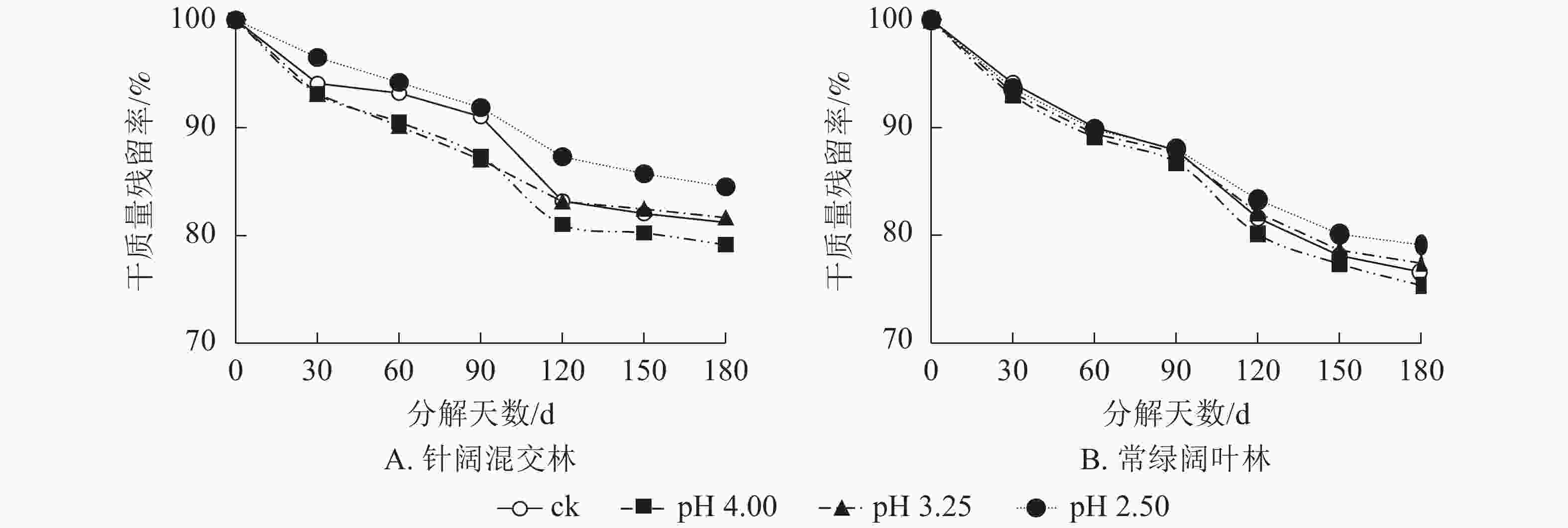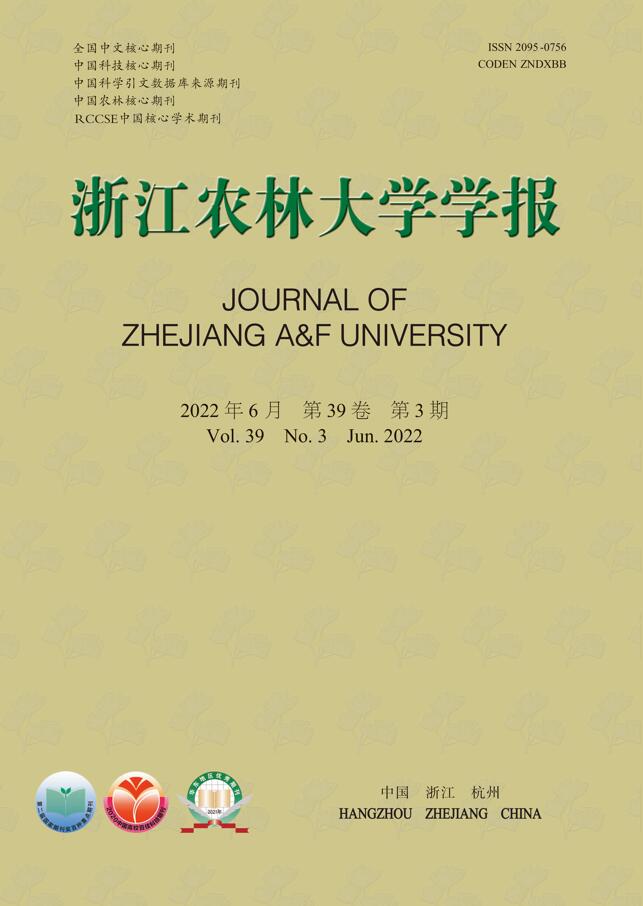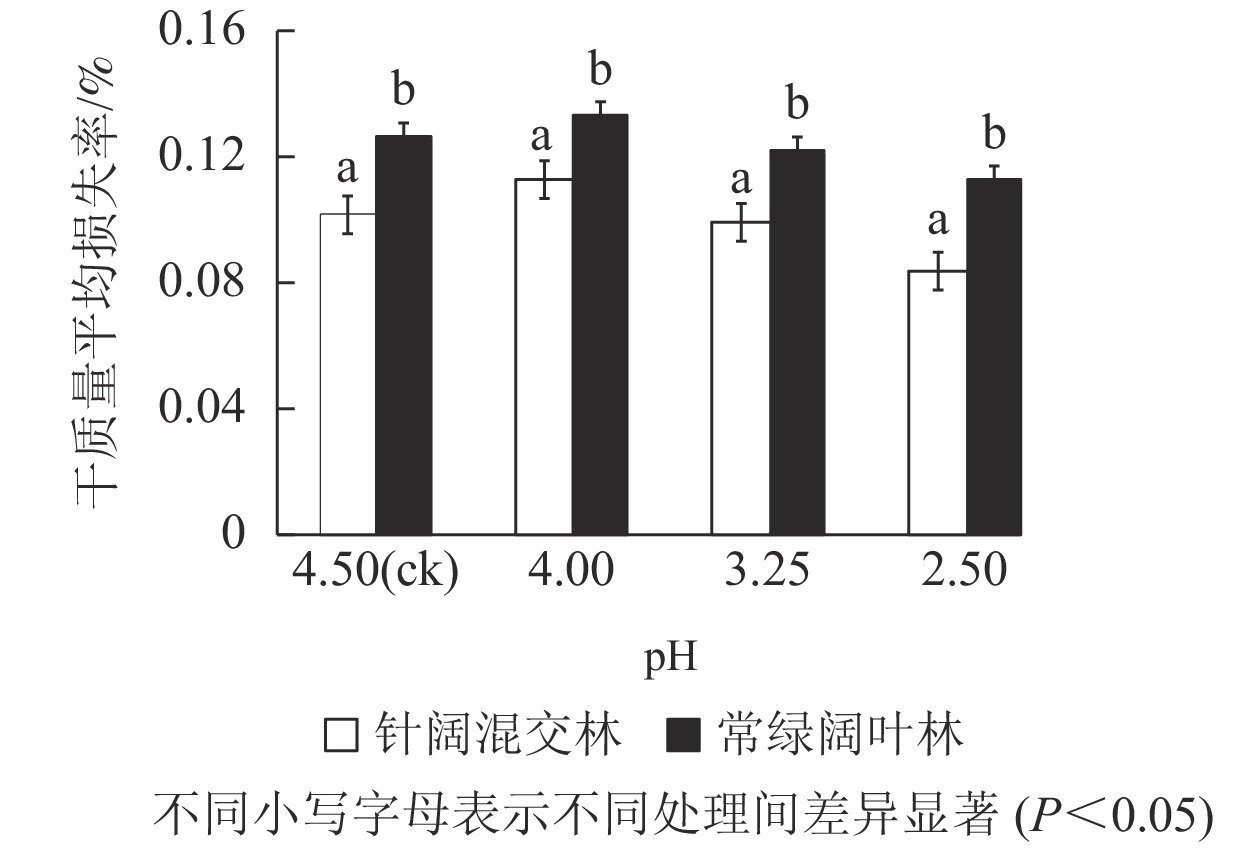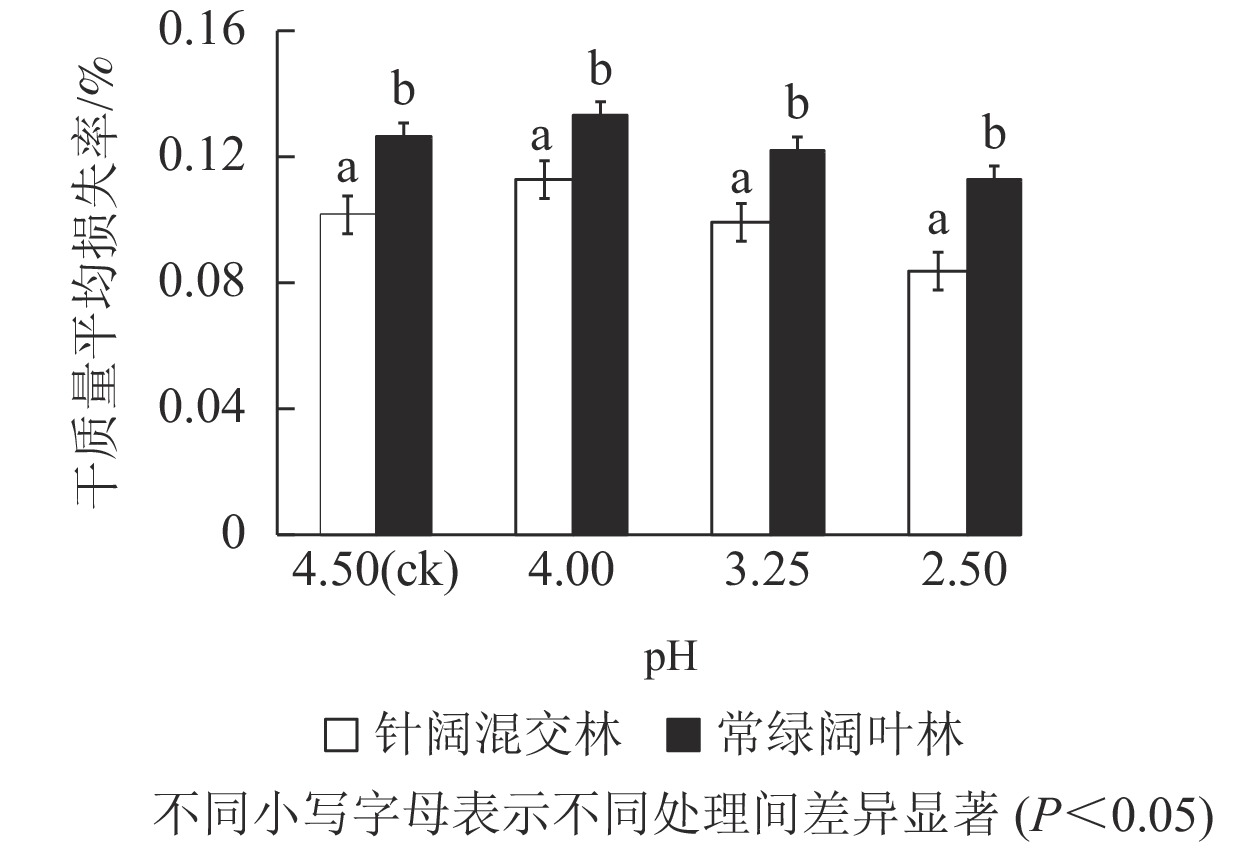-
凋落物分解是调节森林生态系统养分循环的基本生态过程[1],也是控制森林生态系统碳循环的关键决定因素[2]。凋落物分解过程受环境气候、凋落物质量、微生物等多种因素的影响[3-4]。近年来,人类活动引起的全球变化对凋落物分解的影响已成为研究的热点,尤其是酸雨对凋落物分解影响的变化受到国内外学者的普遍关注[4-5]。有研究发现:酸雨对凋落物分解的影响与养分还原、生态系统碳循环和碳平衡、退化生态系统的恢复、生态系统对酸雨的临界负荷等方面具有密切的联系[6],它通过酸解凋落物有机成分而改变凋落物的物理化学结构,从而影响凋落物分解速率,最终改变整个地球碳循环进程[7]。森林凋落物分解速率对环境变化特别是氮沉降和温度增加等[8-9]的研究逐渐丰富,以凋落物分解速率为指标评估酸雨对凋落物分解的影响研究也逐渐开展。目前测定凋落物分解速率的主流方法是分解袋法,即观测分解袋内给定样品量的凋落物的质量损失率,然后根据指数模型来推算分解速率。凋落物分解常数k值是表征凋落物分解速率的常用指标,k值越大,凋落物分解速率越快,反之则越慢[10]。酸雨对凋落物分解会因树种的不同而有明显的差异,酸雨处理下,阔叶树种叶凋落物分解速率比针叶树种的叶凋落物分解速率快[11],马尾松Pinus massoniana凋落物分解比其他树种对酸雨酸碱度更敏感[12]。中国南方是继欧洲和北美以外的世界第三大酸雨区[13]。近几年关于酸雨与凋落物的研究主要集中在单个树种凋落叶上,而对不同林分整体林下凋落物的关注较少[14],同时多侧重于叶凋落物质量所引起的凋落物分解速率的变化,鲜有研究酸雨导致的综合影响。酸雨胁迫对西南地区林分凋落物分解的变化规律尚不明确。因此,本研究选取中国西南酸雨区重庆缙云山的针阔混交林和常绿阔叶林作为研究对象,研究不同酸碱度酸雨处理下凋落物的干质量残留率和分解速率随时间变化的动态过程,分析缙云山针阔混交林与常绿阔叶林凋落物分解在缓解酸雨过程中的特点和规律,以期掌握森林土壤碳库循环,为优化森林管理,指导林分配置提供科学依据。
-
研究区位于三峡库区(重庆段)重庆市缙云山国家级自然保护区,嘉陵江小三峡之温塘峡西岸。缙云山位于重庆市西北部的北碚、沙坪坝、壁山3个区县境内(29°41′~29°52′N,106°17′~106°24′E),海拔为175.0~951.5 m,总面积为76 km2。缙云山具有典型的亚热带季风湿润性气候特征,雨量丰富,年均降水量为1 611.8 mm,年均相对湿度为85%以上,年均酸雨pH 4.53,年均日照时数1 293 h。缙云山地形平缓,土层较薄,主要土壤为黄壤和水稻土两大类,土壤pH 3.5~4.5。保护区内植物资源丰富,森林覆盖率高,林分凋落物保护较好,经营性活动如采伐、施肥、抚育等基本停止。主要植被类型为常绿阔叶林、针阔混交林、常绿阔叶灌丛、暖性针叶林、针阔混交林、竹林,以及亚热带灌草丛等。主要树种为马尾松、四川大头茶Gordonia acuminate、杉木Cunninghamia lanceolata、四川山矾Syraplocos setchuanensis、白毛新木姜子Neolitea aurata等。
-
选取针阔混交林、常绿阔叶林2种典型林分作为研究对象, 样品采集、保存和测定方法严格参照《土壤理化分析》[15],标准样地概况见表1。分别选取10 m×10 m的采样框并用孔径1 mm尼龙网围栏,于2016年5月在2种样地内随机选取5 m×5 m样方各3个,用凋落物收集器直接收集凋落物,收集主要树种与伴生树种的落叶、枯枝、落果、碎屑等,收集到的凋落物在60 ℃恒温下烘至恒量后称量备用。再将采集的凋落物称量20 g装入由尼龙制成的20 cm×20 cm的分解网袋(网孔1 mm)内,由于实验地点内无径流,无大风天气,故编号挂牌后直接将所有尼龙网袋平放在采集针阔混交林与常绿阔叶林凋落物的样方凋落物层中,使其下方接触矿质土壤,上面用凋落物覆盖,每个5 m×5 m的小样方中设置6个摆放点,对应6次取样时间,模拟凋落物分解的自然状况[16]。
林分 表层土壤/cm 海拔/m 坡向 坡度/(°) 龄级 郁闭度 主要树种 伴生树种 针阔混交林 4.00 760 西北 16~25 Ⅵ 0.9 马尾松、四川大头茶、 四川山矾 柃木、四川杨桐、光叶 山矾、白毛新木姜子 常绿阔叶林 3.65 825 西北 26 Ⅵ 0.9 四川大头茶、四川杨桐、 白毛新木姜子 小叶栲、贵州鼠李、四 川山矾、柃木 说明:研究区域均为人工林,以10 a为1个龄级,用Ⅰ、Ⅱ、Ⅲ、Ⅳ······表示。四川杨桐Adinandra bockiana、柃木 Eurya japonica、光叶 山矾 Symplocos lancifolia、小叶栲 Castanopis carlesii、贵州鼠李Rhamnus esquirolii Table 1. Basic situation of the sample plot
-
根据重庆缙云山降水化学组成[17],使用去离子水配制模拟酸雨,其中
${\rm{SO}}_4^{2-}$ 和NO−摩尔比为5∶1。针阔混交林、常绿阔叶林2种典型林分内均设置4个处理:对照(按照自然状态降雨年均pH 4.50设置,ck)、pH 4.00、pH 3.25和pH 2.50。其中,按照降雨pH最低值设置pH 3.25,考虑极端状况下降雨pH可能降低,设置pH 2.50处理。每个处理3次重复,共设 24个分解袋。根据重庆缙云山多年平均降水量计算淋溶总量与淋溶频率[9],喷淋酸雨,每月施酸2次,每次每个样品施酸2 L,均匀喷洒覆盖样品周围1 m2范围。分别在样品放置后的第30天(6月2日)、第60天(7月2日)、第94天(8月3日)、第122天(9月2日)、第150天(10月1日)和第185天(11月3日),取回1次凋落物分解袋,每次每个酸雨酸碱度取样3袋,合计24袋。用清水快速洗净残留凋落物表面附着的泥沙,清理外界长入分解袋内的根系杂物,于80 ℃烘箱中烘干称量,测定残留凋落物的质量。 -
凋落物累积分解残留率采用Olson负指数衰减模型[18]计算:
其中:y为凋落物残留率(%),t为凋落物分解时间(a),Mt为时间t后凋落物残留质量(g),M0为凋落物样品未分解时质量(g),a为拟合系数,m为分解系数。用凋落物分解常数k值估算凋落物分解的半衰期与全衰期,计算公式如下 [19]:
其中:t0.5为凋落物分解至50%(半衰期)需要的时间(a),t0.95为凋落物分解至95%(全衰期)需要的时间(a)。
-
采用Excel 2019软件整理数据,采用SPSS 26.0软件进行统计分析,采用LSD最小差异显著法多重比较。
-
由图1和图2可见:针阔混交林干质量残留率(经历相同分解时间)在pH 4.00、pH 3.25的酸雨处理下小于ck,在pH 2.50的酸雨处理下大于ck,且差异显著(P<0.05)。受控试验表明:凋落物在经过0.5 a的分解后,针阔混交林ck、pH 4.00、pH 3.25和pH 2.50酸雨处理的干质量残留率分别为81.21%、79.14%、81.65%和84.52%,干质量损失率分别为18.79%、20.86%、18.35%和15.48%;常绿阔叶林ck、pH 4.00、pH 3.25和pH 2.50酸雨处理的残留率分别为76.61%、75.36%、77.43%和79.13%,干质量损失率分别为23.39%、24.64%、22.57%和20.87%。在经过0.5 a的分解后,ck、pH 4.00、pH 3.25和pH 2.50酸雨处理后的针阔混交林干质量残留率均高于常绿阔叶林,分别高4.60%、3.78%、4.22%和5.39%。

Figure 1. Changes in dry weight remaining of leaf litter decomposition of three typical tree species
在相同pH值酸雨处理下,针阔混交林、常绿阔叶林凋落物在6—7月(即30~60 d)干质量残留率曲线平缓,8—9月(即94~122 d)曲线下降幅度较大,表明在相同pH值处理下,针阔混交林、常绿阔叶林在6—7月分解缓慢,5月、8—9月凋落物分解较为迅速。随着时间的推移,针阔混交林在9月(122 d)后凋落物分解速率降低,呈平缓趋势,常绿阔叶林在9月后凋落物分解速率仍达到较高水平,下降明显。在相同月份下,凋落物干质量残留率在pH 2.50处理下最高,pH 4.00处理最低。
-
由表2可见:利用Olson负指数衰减函数模型对针阔混交林和常绿阔叶林的凋落物干质量残留率和分解时间进行拟合,R2均在0.9以上,达极显著水平,拟合效果良好。ck、pH 4.00、pH 3.25和pH 2.50各处理下针阔混交林的k值分别为0.43、0.47、0.40和0.35,而常绿阔叶林则分别为0.54、0.56、0.51 和0.46,k值随pH值的降低呈下降趋势。另外由k值可算得,ck中针阔混交林凋落物质量损失率达50%和95%的时间分别为1.62和6.98 a,常绿阔叶林则分别为1.29和5.56 a;pH 4.00酸雨处理下针阔混交林凋落物干质量损失率分别达50%和95%的时间分别为1.47和6.35 a,常绿阔叶林则分别为1.23和5.33 a;pH 3.25酸雨处理下针阔混交林凋落物干质量损失率达50%和95%的时间分别为1.75和7.56 a,常绿阔叶林则分别为1.37和5.92 a;pH 2.50酸雨处理下针阔混交林凋落物干质量损失率达50%和95%的时间分别为2.00和8.63 a,常绿阔叶林则分别为1.50和6.48 a,且针阔混交林与常绿阔叶林在各酸雨酸碱度下差异显著(P<0.05)。针阔混交林与常绿阔叶林在pH 2.50与pH 3.25酸雨处理下的分解速率均小于ck,半衰期与周转期所需的时间均比ck长;pH 4.00酸雨处理的分解速率较ck大,半衰期与周转期所需的时间比ck短。
林分 pH 指数模型 相关
系数R2分解
系数k半衰期
/a
全衰期
/a针阔
混交林4.50 (ck) y = 99.13e−0.43x 0.93 0.43 a 1.62 b 6.98 b 4.00 y = 97.98e−0.47x 0.95 0.47 b 1.47 ab 6.35 ab 3.25 y = 97.20e−0.40x 0.93 0.40 a 1.75 b 7.56 b 2.50 y = 99.60e−0.35x 0.98 0.35 a 2.00 b 8.63 b 常绿
阔叶林4.50 (ck) y = 99.08e−0.54x 0.98 0.54 b 1.29 a 5.56 a 4.00 y = 98.53e−0.56x 0.98 0.56 ab 1.23 a 5.33 a 3.25 y = 98.33e−0.51x 0.97 0.51 b 1.37 a 5.92 a 2.50 y = 98.20e−0.46x 0.97 0.46 b 1.50 ab 6.48 ab 说明:不同小写字母表示不同处理间差异显著(P<0.05)。y为凋落物干质量残留率,x为凋落物分解时间 Table 2. Olson negative exponential decay model of litter decomposition
-
在同一观测阶段,缙云山针阔混交林、常绿阔叶林凋落物随着酸雨pH值的减小,凋落物干质量残留率均表现出先增大后减小的趋势,在pH 4.00时达到最小值,此时分解速率最大。这与程煜等[13]研究得出的不同酸碱度酸雨对凋落物分解速率的影响结果一致。可能是pH 4.00的模拟酸雨酸碱度与ck差距不大,且土壤本身存在酸缓冲能力,同时模拟酸雨中的
${\rm{NO}}_3^- $ 作为氮源添加刺激了土壤微生物,从而提高了分解效率[20]。而pH 2.50和pH 3.25的模拟酸雨酸碱度过低导致微生物活性和功能降低,且在一定范围内随着酸雨淋溶酸碱度的降低[21-22],分解速率愈加减慢,表现为调落物分解被抑制。 -
本研究发现:相同pH值的酸雨处理下,针阔混交林、常绿阔叶林凋落物在6—7月、10—11月凋落物分解缓慢,5月、8—9月分解较为迅速。可能因为:5月属于分解初期,凋落物可溶性成分大量淋失,导致分解速率较高;6—7月,难分解的物质相对增加,温度相对变化不大,分解速率主要受微生物控制;8—9月,由于夏季温度升高,水分充足,针阔混交林、常绿阔阔叶林地表植被活性大,微生物活性提高,分解速率增大;而10—11月,气温降低,地表植被逐渐进入冬寒期,微生物活性受到影响,分解速率减缓。在同一区域内,温度和湿度是众多气候因素中制约凋落物分解的主要外在因素,水分和温度增加,凋落物的分解速率会以指数增加模式呈现[23-24]。HORNSBY等[25]在研究树木凋落物的分解速率时发现:凋落物的分解速度随着分解时温度的升高而加快,分解温度与分解速度呈正相关关系;王其兵等[26]通过测定草地凋落物分解速率的研究中也得出了相同结论。本研究分析随季节温度变化研究地的水热、pH等条件改变,从而影响了部分微生物的活性,甚至是土壤中H+的积累,进而对凋落物的分解速率产生了较大的影响。本研究中由于人工控制降水量,前期不同季节月份中水分条件差异小,湿度因素对分解速率产生的影响差异小,这使得气候变化导致的温度变化影响了2种林分凋落物的分解速率。
-
不同酸碱度酸雨淋溶下2种典型林分凋落物干质量损失率达50%和95%的时间总体表现为常绿阔叶林早于针阔混交林。针阔混交林和常绿阔叶林凋落物k对同一酸碱度酸雨胁迫响应不同,说明不同树种的林下凋落物分解速率有差异。在经过0.5 a的分解后,常绿阔叶林凋落物分解速率大于针阔混交林,符合阔叶凋落物比针叶凋落物易于分解的一般规律。阔叶林微生物群落对外部酸的抵抗力高于针叶林[27],其凋落物比针叶凋落物易于分解。植物种类也会影响凋落物的初始化学特性[28-29]。混合凋落物比单一凋落物含有丰富多样的碳源和其他养分物质[30],针叶类凋落物添加阔叶类后碳源种类和数量发生改变[31],导致土壤微生物量和微生物碳代谢强度减少,因此相对降低了凋落物的分解速率,但是这种作用的影响程度是否能够改变酸雨淋溶产生的影响还需要进一步研究。
本研究模拟酸雨喷洒时间较短,尚不能确定西南地区亚热带森林对长期酸雨胁迫如何响应及酸雨的促进或者抑制作用是否已经达到一定阈值。此外,凋落物能缓冲酸雨反应,林下植物对凋落物分解也产生一定联系作用[32]。因此,未来应同步开展多林分凋落物质量、叶片性能和林下植物对酸雨输入响应的长期野外研究,以更好地揭示长期酸雨沉降对亚热带森林的综合影响。
-
综上,重庆缙云山针阔混交林和常绿阔叶林凋落物质量残留率、半衰期和全衰期的变化特征受不同酸碱度酸雨影响显著,模拟酸雨pH 4.00处理时凋落物分解速率最大,常绿阔叶林分解速率总体高于针阔混交林。在同一区域范围内,除酸雨酸碱度、凋落物种类之外,凋落物分解速率还受到温度条件的制约。
Effects of simulated acid rain leaching on the litter decomposition of coniferous broad-leaved mixed forest and evergreen broad-leaved forest in Mount Jinyun
doi: 10.11833/j.issn.2095-0756.20210350
- Received Date: 2021-05-07
- Accepted Date: 2021-11-25
- Rev Recd Date: 2021-11-20
- Available Online: 2022-05-23
- Publish Date: 2022-05-23
-
Key words:
- acid rain /
- Mount Jinyun /
- litter /
- decomposition /
- coniferous and broad-leaved mixed forest /
- evergreen broad-leaved forest
Abstract:
| Citation: | AN Xiaonan, WANG Yunqi, LI Yifan. Effects of simulated acid rain leaching on the litter decomposition of coniferous broad-leaved mixed forest and evergreen broad-leaved forest in Mount Jinyun[J]. Journal of Zhejiang A&F University, 2022, 39(3): 516-523. DOI: 10.11833/j.issn.2095-0756.20210350 |













 DownLoad:
DownLoad:
